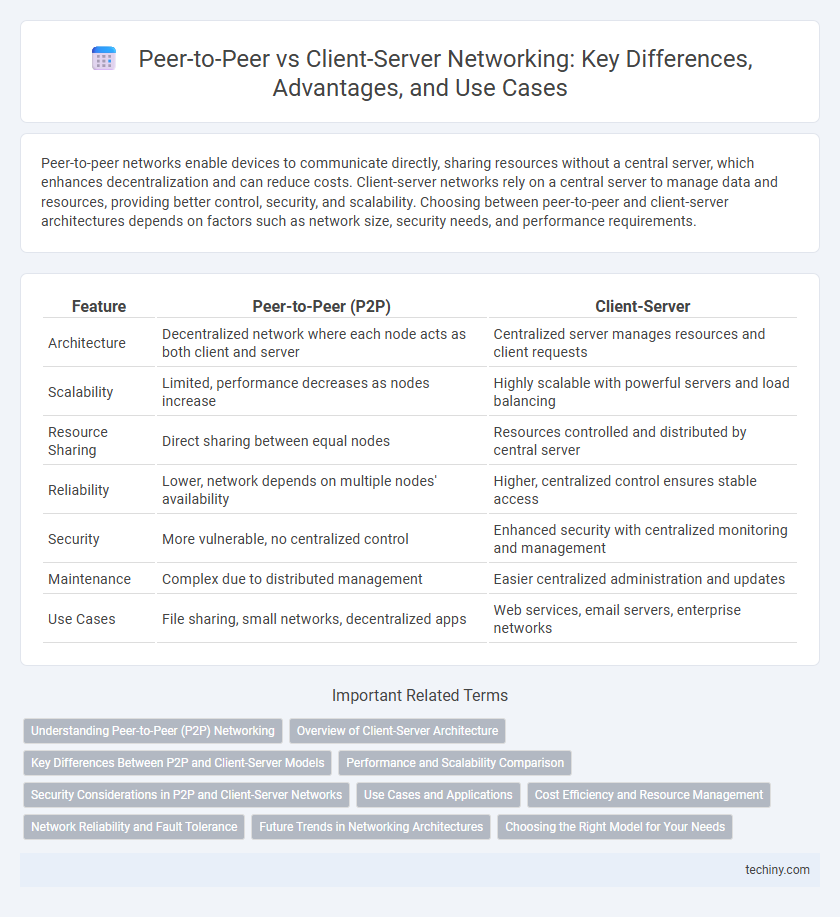Peer-to-peer networks enable devices to communicate directly, sharing resources without a central server, which enhances decentralization and can reduce costs. Client-server networks rely on a central server to manage data and resources, providing better control, security, and scalability. Choosing between peer-to-peer and client-server architectures depends on factors such as network size, security needs, and performance requirements.
Table of Comparison
| Feature | Peer-to-Peer (P2P) | Client-Server |
|---|---|---|
| Architecture | Decentralized network where each node acts as both client and server | Centralized server manages resources and client requests |
| Scalability | Limited, performance decreases as nodes increase | Highly scalable with powerful servers and load balancing |
| Resource Sharing | Direct sharing between equal nodes | Resources controlled and distributed by central server |
| Reliability | Lower, network depends on multiple nodes' availability | Higher, centralized control ensures stable access |
| Security | More vulnerable, no centralized control | Enhanced security with centralized monitoring and management |
| Maintenance | Complex due to distributed management | Easier centralized administration and updates |
| Use Cases | File sharing, small networks, decentralized apps | Web services, email servers, enterprise networks |
Understanding Peer-to-Peer (P2P) Networking
Peer-to-Peer (P2P) networking allows devices, or nodes, to connect and share resources directly without relying on a centralized server, enhancing scalability and fault tolerance. Each node in a P2P network functions as both a client and a server, enabling efficient distribution of data and reducing bottlenecks common in Client-Server architectures. This decentralized model supports applications such as file sharing, blockchain, and collaborative platforms by fostering equal participation among connected devices.
Overview of Client-Server Architecture
Client-server architecture centralizes resources and services in dedicated servers that respond to requests from multiple client devices, enhancing scalability and control. This model supports efficient resource management, security, and simplified maintenance by segregating roles between clients, which initiate requests, and servers, which process and deliver data. It is commonly used in web services, databases, and enterprise applications to ensure robust and reliable network communication.
Key Differences Between P2P and Client-Server Models
Peer-to-peer (P2P) networks distribute resources and responsibilities evenly among all nodes, enhancing scalability and fault tolerance, while client-server models centralize control in a dedicated server that handles requests from multiple clients, ensuring efficient management and security. P2P networks typically exhibit lower setup costs and increased resilience due to direct data sharing, whereas client-server architectures rely on robust server infrastructure for performance and centralized administration. The choice between P2P and client-server depends on factors like network size, resource sharing needs, and security requirements, with P2P favored for decentralized systems and client-server for controlled, hierarchical environments.
Performance and Scalability Comparison
Peer-to-peer (P2P) networks distribute workload among nodes, enhancing scalability by allowing each peer to share resources and handle data processing, resulting in better performance as the network grows. In contrast, client-server architectures rely on central servers that can become bottlenecks under high demand, limiting scalability and often requiring significant server upgrades to maintain performance. P2P systems excel in dynamic environments with fluctuating network sizes, while client-server models provide consistent performance for controlled, smaller-scale applications.
Security Considerations in P2P and Client-Server Networks
Peer-to-peer (P2P) networks face increased security risks due to decentralized control, making it challenging to enforce consistent access policies and detect malicious nodes. In contrast, client-server networks centralize security management, enabling easier implementation of authentication, authorization, and monitoring systems to safeguard sensitive data. The lack of a central authority in P2P networks heightens vulnerability to attacks such as data interception, spoofing, and unauthorized access, necessitating robust encryption and trust mechanisms.
Use Cases and Applications
Peer-to-peer (P2P) networks excel in decentralized applications such as file sharing, blockchain, and collaborative platforms, enabling direct data exchange without centralized control. Client-server architectures dominate in environments requiring centralized data management, like web hosting, enterprise databases, and cloud services, providing scalability and security. Understanding the specific requirements for control, scalability, and resource distribution guides the choice between P2P and client-server models in networking use cases.
Cost Efficiency and Resource Management
Peer-to-peer networks reduce costs by eliminating the need for dedicated servers, allowing devices to share resources directly, which enhances cost efficiency for small-scale or decentralized setups. In contrast, client-server architectures require significant investment in central servers and maintenance but offer superior resource management through centralized control, scalability, and easier data backup. Efficient resource allocation and lower hardware expenses make peer-to-peer ideal for informal networks, while client-server systems optimize performance and security in enterprise environments.
Network Reliability and Fault Tolerance
Peer-to-peer networks enhance fault tolerance by distributing data and services across multiple nodes, reducing single points of failure and improving network reliability. Client-server architectures depend on centralized servers, which can create bottlenecks and single points of failure but simplify management and maintenance. Redundancy and decentralized resource sharing in peer-to-peer models significantly increase resilience against node failures compared to client-server systems.
Future Trends in Networking Architectures
Peer-to-peer (P2P) networks are evolving with decentralized blockchain integration, enhancing security and scalability for future applications like IoT and edge computing. Client-server architectures continue to leverage cloud computing advancements, enabling dynamic resource allocation and centralized management for enterprise environments. Hybrid models combining P2P and client-server elements are emerging, optimizing performance, fault tolerance, and data distribution for next-generation networking solutions.
Choosing the Right Model for Your Needs
Selecting the appropriate networking model depends on factors like scalability, control, and resource distribution. Peer-to-peer networks offer decentralized data sharing ideal for small, equal-status nodes, while client-server architectures provide centralized management suitable for large-scale applications requiring security and consistent availability. Evaluating your network's size, security needs, and maintenance capabilities ensures the optimal choice between peer-to-peer and client-server models.
Peer-to-Peer vs Client-Server Infographic

 techiny.com
techiny.com